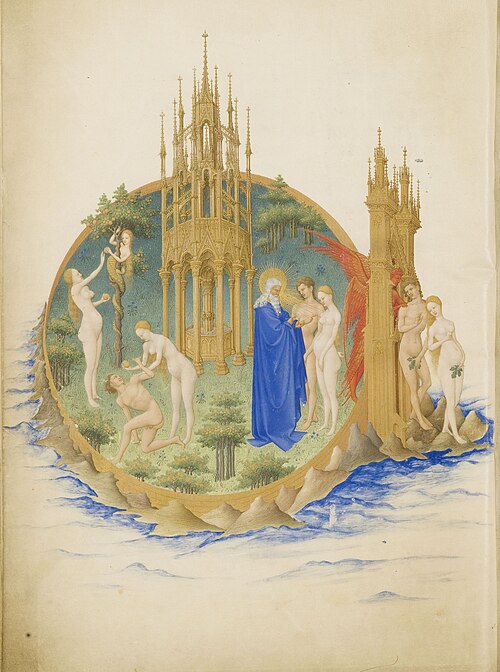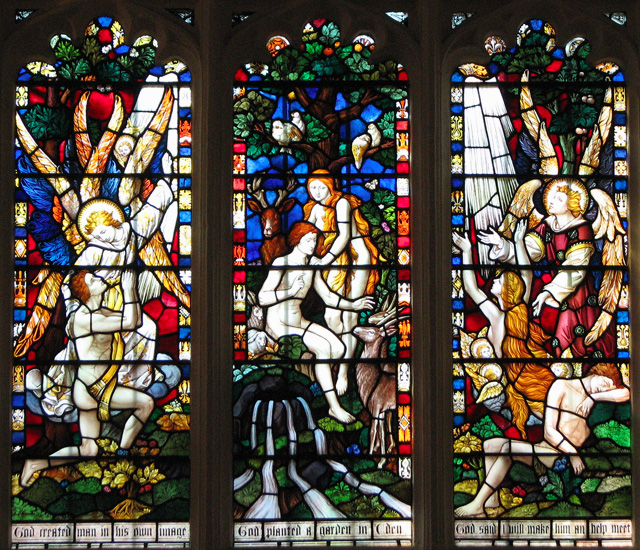Adam#
(ad’ em) HEBREW: ADAM
“human being” or “mankind”
The book of Genesis provides two versions of the creation of the first man, Adam. In the first chapter, a male and female are created “in the image of God’ (Gen. 1:27) on the six day of creation. Blessed and set above all of the other animals, this pair is given a specific command: “be fruitful and multiple, and fill the earth and subdue it; and have dominion over the fish of the sea and over the birds of the air and over every living thing that moves upon the earth” (Gen. 1:28). Furthermore, God makes clear that sufficient food has been provided for all living creatures, humans included, in the form of green plants and fruit-bearing trees. The world thus begins without the need to struggle for survival, with all of creation in perfect balance and harmany.
In the second chapter of Genesis, which is apparently based on a different oral tradition, the creation of all heaven and earth was not yet complete when God scooped up some dust from the grdound (which had been watered only by a terrestrial mist), shaped a man from it, and brought him to life by breathing into his nostrils “the breath of life” (Gen. 2:7). Perhaps the name Adam originated with the Hebrew word adom, meaning red, because of the color of the clay used to make him, or from adamah, which means earth.

Fig. 3 Adam and Eve in their earthly paradise; an illumination from a 15th-century devotional book. (Image courtesy of Wikimedia, Public Domain. Accessed on August 26, 2025.)#
Next, the Creator planted the garden of Eden somewhere “in the east” (Gen. 2:8) and charged his new subject with the task of tilling this fertile paradise, whose flowing stream divided into four great rivers that reached to the corners of the earth – the Pishon, the Gihon, the Tigris, and the Euphrates. The man was granted free use of the garden’s fruit trees, with one significant exception: Death was the panelty for eating from the “tree of knowledge of good and evil” (Gen. 2:17).
Concluding that “it is not good that the man should be alone” (Gen. 2:18), God created the world’s animals and birds to be companions and helpers for the lone human, who was given the privilege and responsibility of naming them. When non provided to be a suitable helper for him, however, God put him to sleep, took one of the man’s ribs, and used it to form Eve, the first woman. “Therefore,” comments the writer of this account, “a man leaves his father and his mother and cleaves to his wife, and they become one flesh” (Gen. 2:24).
These two separate versions of Adam’s creation contain significant theological points. In the first, the human is created on the same day as the animals but is purposely set apart, infused with the divine spirit, and given dominance over earthly creation. In both, he is given a life of ease and abundance, blessed as the favorite of the Lord God of the universe.
For ancient readers, the next turn in the story is indicated by the very word Adam, since it was frequently used in ancient Hebrew to mean human being or mainkind. therefore, when he decides to commit the first sin and suffers the consequences, Adam represents the plight of all humanity in struggling to be worthy of God’s love. Before this sin, Adam and Eve lived together happily in a literal paradise, free from pain, hunger, and thirst. Food was abundant, including the frunt of the “tree of life” (Gen. 3:22), which apparently gave them eternal life. There was no need for clothing, and the animals and birds cooperated with the human pair.
Eventually, however, a serpent seduced Eve into breaking God’s commandment by eating the frunt of the forbidden tree “in the midst of the garden” (Gen. 2:9) and sharing it with Adam. Instantly, the couple became conscious for the first time that they were naked. Hastily stitching fig leaves together into aprons, terrified by their guilt, they frantically tried to hide from their creator behind the trees of Eden.

Fig. 4 The four rivers of Eden appear in this stained-glass (center) depiction of Adam and Eve. The stain glass is from the west window of St. Edmundsbury Cathedral. (Image courtesy of Wikimedia, licensed under the Creative Commons Attribution-Share Alike 2.0 Generic license. Attribution: St Edmundsbury cathedral, Bury St Edmunds - Victorian glass by Evelyn Simak. Accessed on August 26, 2025.)#
When God saw that they had become ashamed of their nakedness, he knew that they had broken his commandment. Punishment was swift and severe not only for Adam and Eve, but also for all humankind to follow them. Yet the sentence of death itself would not be fulfilled at once. Rather, the lot of the woman would be to suffer increased physical anguish in childbirth and subservience to her husband. The man would now have to earn his food by sweat and heavy labor, wrestling it from soil that God cursed and made hostile. Both were expelled forever from Eden and barred from access to the tree of life. Mortal existence would henceforth be burdened with tribulation and woe from cradle to grave, when man would return to the very dust from which God had originally created him.
